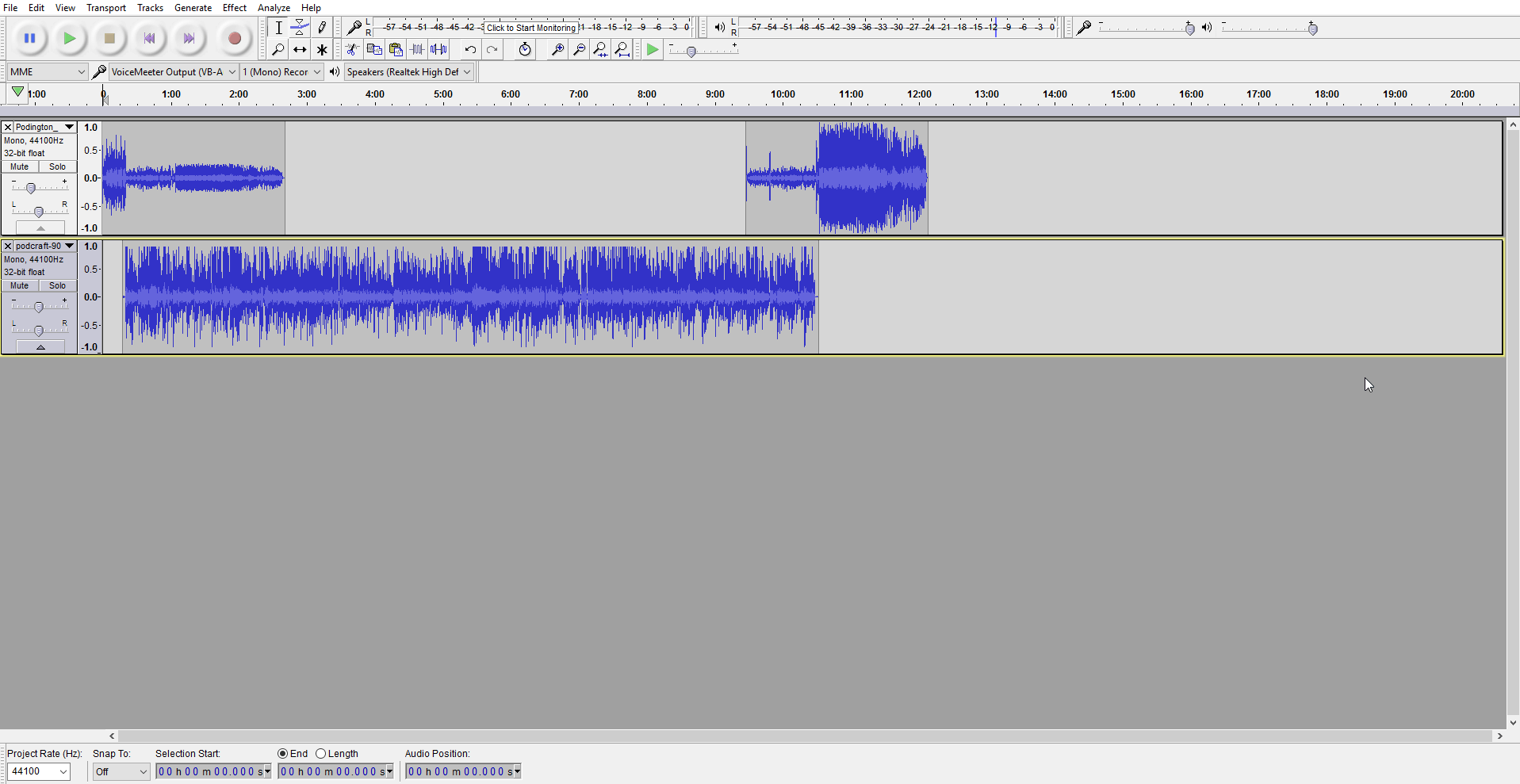Overview Audacity is a Free digital audio editor, written by a team of volunteer developers around the world. It is fully cross-platform, with versions being available for Windows, Linux and MAC OS X. Audacity Pricing: Audacity is a free software. Audacity pricing makes it a desirable software with an array of premium like functionalities. Music professionals and enthusiasts can download and install the software from the website without worrying about Audacity pricing. Download the free Audacity audio editor for Windows, Mac or Linux from our download partner, FossHub: Download Audacity for Windows, Mac or Linux; Audacity is free of charge. No registration or hardware purchase required. Audacity on Windows is only available as a 32-bit application that may be used on 32-bit or 64-bit systems.
1 Reasons People Like Using AudacityWhich Do We Choose?
Do you want to save a bit of time? Just get the following and you will be good to go! All you need is Audacity and some good training videos to go with it and you will be up and running super quickly!
- Step 1 – Download Audacity For Free Here
- Step 2 – Get The Best Training For Audacity Here With Audacity Workshop
These Are All You Need! But, if you want more details, read on!
Recording your podcast successfully will require you to make a choice between popular editing software. While there are many audio editing tools available, there are two common products that are most often utilized by both beginners and professionals. If you are wondering about the difference between Audacity vs Garageband for podcasting, then you will find this guide helpful.

Both of the software packages have numerous elements that people like and dislike. A basic overview of the most liked and disliked features is showcased in this guide.
Reasons People Like Using Audacity
Cost
Unlike some editing packages, users do not have to pay money to download and use this software. Since the first version was released in May of 2000, there has never been a fee in order to use Audacity as a podcast editor. This makes it a very cost-effective approach for starting out on a low budget.
Operating System Compatibility
Not every person who creates digital audio files uses only one type of computer system. Cross-platform operating system support has always been offered with Audacity from the beginning. This means that if you are using Windows, Linux, Unix or MacOS, you will be perfectly fine.
Easy Audio Export
Creating files that are in the right format to upload to iTunes is simple with Audacity. The engineers have pre-programmed the software to automatically export an AAC file which is the preferred format for uploading content on the App store website. So if you plan to use iTunes for your podcast distribution, exporting your audio is a simple one-click method.
Pre-Installed Effects
In order to make a podcast that uses effects like reverb, noise removal or compression, you will need access to effects. With Audacity, there are pre-installed effects that are excellent for podcasters. You do not have to buy third-party effects packages in order to take advantage of the digital audio mastering that Audacity provides.
Large User Community
Due to its open source popularity, Audacity has an ever-growing user community around the world. With a detailed manual and multiple web forums, new and established users can learn tips and tricks for using this software to edit podcast audio easily. This makes creating your first or a series of podcasts simpler due to the amount of helpful articles and videos that can be accessed.

Plug and Play

If all you have is a USB microphone or one that connects through a mixer, Audacity simplifies hooking up audio sources. Because the software has been programmed to work with almost every sound card, plugging in a microphone and immediately recording your digital audio file is simple.
** If you plan to use Audacity, I also recommend looking at this Audacity Workshop review. Using this detailed Audacity course will definitely bring you up to speed quickly!
Reasons People Like Using Garageband

VST Plugin Support
The use of virtual instrument plugins can aid a podcaster in creating music tracks, mastering audio and adding equalization to a sound file. Garageband provides support for third-party VST plugins. This capability does provide more professional sound quality versus free open source programs.
Apple Products Compatibility

Since Apple created Garageband, it is also available for the iPad and other products. This flexibility does allow a person to record a podcast on a tablet, Mac laptop or a standard Apple desktop computer. Because all Apple computers come with Garageband pre-installed, there is no download necessary to get started using the software.
Audio Interface Support
Because Garageband is useful for both audio editing and music creation, support for multiple digital audio interfaces is included. If you plan to use Skype to record phone calls and interviews in your podcast, you will likely need to have a multiple input and output recording interface. The ability to record multiple streams of audio is something to consider when making a Garageband and Audacity comparison.
Music Loop Creation
Some podcasters find it helpful to create a music bed that plays underneath recorded speech. Garageband simplifies a way to create music loops that utilize pre-installed instruments or built-in sounds. Anyone, regardless of a musical background, can create intro music or a music bed in just a few clicks of a mouse. Detailed editing like stretching audio, silencing portions of music, ducking and seamless audio crossfades are included.
Real Time Effects
One thing that Garageband does well that Audacity does not is the ability to add in effects to an audio file in real time. During recording or playback, an effect can be selected and used for one or more tracks. The audio playback will have the effect included without having to process the file first. This is a real time saver for someone who prefers to use effects in real time while recording podcasts.
Vocal Presets
If you are unhappy with your speaking voice, Garageband has built-in presets that provide pre-mixed vocal effects that can be added to your voice. The narration vocal, bright vocal, compressed vocal and natural vocal instantly create a pleasing tone to your recorded voice. Because effects can be turned on or off, you are not stuck with what you record if you do not like the sound of your voice.
Summary
As a podcaster, you now know the difference between Audacity vs Garageband for podcasting. The great thing is that you have access to free podcast recording software regardless of which program you choose. Determining the exact requirements of your show will assist you in making a decision about which platform to use for recording, editing or for both.
If you only want a simple way to record your voice, add an effect or two and publish your podcast on the Internet, Audacity audio software will be a good choice. You can cut, edit, paste, trim, silence and normalize your audio files to get a better sound. You can also create multiple file formats that are required for upload to SoundCloud, YouTube and other distribution sources.
If you prefer to have more advanced editing or loop features, add image files to your podcast or want easier mixing capabilities, then Garageband might be the best choice. Having the correct tools in place can help you record ear-pleasing MP3, WAV or AAC files that can be shared and uploaded effortlessly online.
Audacity is a Free digital audio editor, written by a team of volunteer developers around the world. It is fully cross-platform, with versions being available for Windows, Linux and MAC OS X. It supports a number of different file formats including uncompressed formats such as WAV & AIFF, but also MP3 (via the separately-downloadable LAME encoder), and interfaces to FLAC (Free Lossless Audio Codec). It compares pretty well to commercial products such as Adobe Audition & Sony Soundforge and is a useful tool for Ad Hoc audio recording, editing and format translation. Plug-in effects include compression, filters, reverb & delays, noise removal.
IT Pro Reviews of Audacity
Audacity Reviews 2020
How Much Does Audacity Cost
